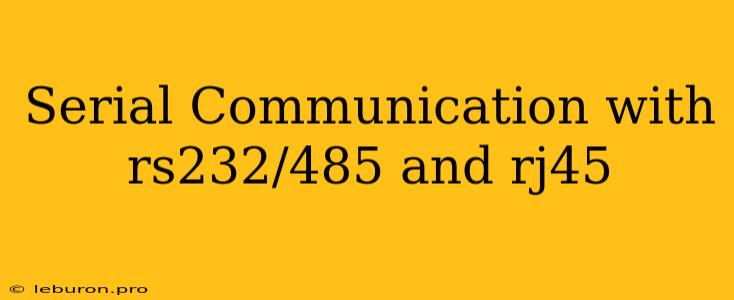Serial communication is a fundamental aspect of many embedded systems and industrial applications, enabling the transfer of data between devices over a single channel. Two common standards used for serial communication are RS-232 and RS-485, each with its own advantages and applications. These protocols are often implemented using RJ-45 connectors, providing a standardized interface for connecting devices. This article delves into the nuances of serial communication with RS-232/485 and RJ-45, exploring their principles, applications, and considerations for successful implementation.
Understanding Serial Communication
Serial communication is a method of transmitting data one bit at a time over a single channel. This contrasts with parallel communication, where multiple bits are transmitted simultaneously over multiple channels. Serial communication is commonly used in applications where simplicity, cost-effectiveness, and long-distance transmission are crucial.
Advantages of Serial Communication
- Simplicity: Serial communication requires fewer wires than parallel communication, simplifying cabling and connectors.
- Cost-effectiveness: Using fewer wires reduces material costs and complexity, making serial communication more economical.
- Long-distance transmission: Serial communication is better suited for transmitting data over long distances, especially with RS-485.
- Flexibility: Serial communication can be easily implemented with various devices and protocols.
RS-232: The Standard for Short-Distance Communication
RS-232 (Recommended Standard 232) is a standard for serial communication that was originally developed for data transmission between computers and modems. It operates at relatively low speeds, typically up to 20 kilobits per second (kbps), and is primarily used for short-distance communication.
RS-232 Characteristics:
- Voltage levels: RS-232 uses voltage levels to represent data, with a positive voltage representing a logic "1" and a negative voltage representing a logic "0".
- Single-ended transmission: RS-232 is a single-ended transmission protocol, meaning that data is transmitted on a single wire.
- Short distances: Due to its voltage levels, RS-232 is limited to short distances, typically up to 15 meters.
- Common Applications: RS-232 is often used in applications like connecting computers to modems, printers, and other peripheral devices.
RS-485: For Reliable Long-Distance Communication
RS-485 is a standard for serial communication designed for reliable long-distance transmission in industrial and commercial environments. It employs differential signaling, where data is transmitted on a pair of wires, offering several advantages over RS-232.
RS-485 Advantages:
- Differential signaling: RS-485 uses differential signaling, where data is transmitted as the difference in voltage between two wires, reducing noise susceptibility and increasing transmission distance.
- Multidrop capability: RS-485 supports multidrop communication, enabling multiple devices to share the same communication bus.
- Long distances: RS-485 can achieve transmission distances up to 1200 meters.
- High speed: RS-485 can operate at speeds up to 10 megabits per second (Mbps).
- Common Applications: RS-485 is commonly used in industrial automation, process control, and data acquisition systems.
RJ-45 Connectors: A Standard Interface for Serial Communication
RJ-45 connectors are widely used in serial communication with RS-232/485 for their ease of use and standardized design. These connectors have eight pins and are commonly associated with Ethernet, but they are also used for other protocols like RS-232 and RS-485.
RJ-45 Pinouts for RS-232 and RS-485:
The pinout for RJ-45 connectors varies depending on the specific RS-232/485 configuration used. Some common pinouts include:
- RS-232: Pins 1 and 2 are typically used for transmitting and receiving data, while other pins may be used for ground, handshake signals, or other functionalities.
- RS-485: Pins 1 and 2 are used for transmitting and receiving data, while pins 3 and 6 are commonly used for the differential signal ground. Other pins may be used for additional functionalities.
Implementing Serial Communication with RS-232/485 and RJ-45
Implementing serial communication with RS-232/485 and RJ-45 requires careful consideration of the specific application, the chosen standard, and the desired data transmission rate.
Key Considerations:
- Data rate: Selecting the appropriate data rate is crucial to ensure reliable data transmission.
- Cable length: The maximum distance between devices should be within the limitations of the chosen RS-232/485 standard.
- Noise: Implementing proper shielding and grounding is essential to minimize noise interference.
- Termination: Terminating the communication bus with a resistor at the end is essential to prevent signal reflections in RS-485 applications.
- Parity: Parity checking can be used to detect errors during data transmission.
Conclusion
Serial communication with RS-232/485 and RJ-45 remains a fundamental aspect of many embedded systems and industrial applications, offering a reliable and cost-effective means of exchanging data between devices. Choosing the appropriate standard and considering the key implementation aspects are essential for successful communication. The versatility and affordability of these protocols make them an integral part of modern technology, enabling seamless data exchange and control in diverse applications.
